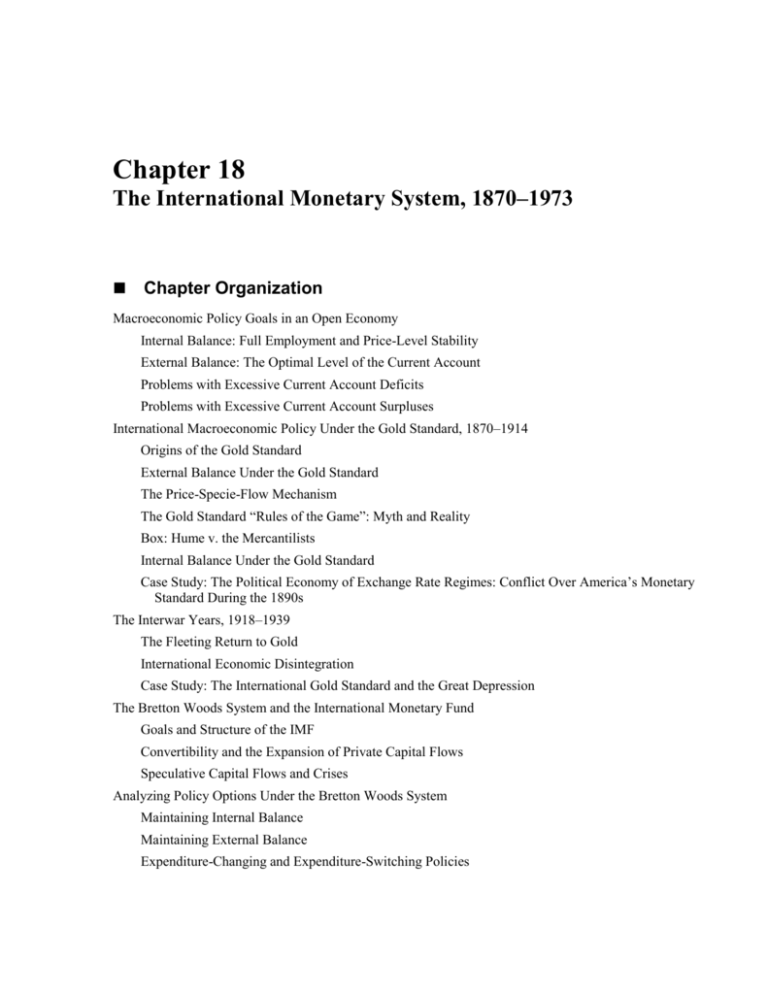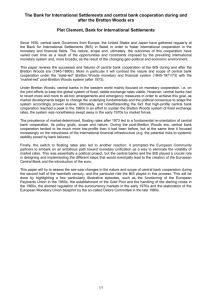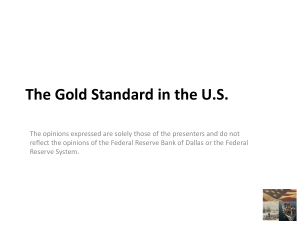CHAP1.WP (Word5)
advertisement

Chapter 18 The International Monetary System, 1870–1973 Chapter Organization Macroeconomic Policy Goals in an Open Economy Internal Balance: Full Employment and Price-Level Stability External Balance: The Optimal Level of the Current Account Problems with Excessive Current Account Deficits Problems with Excessive Current Account Surpluses International Macroeconomic Policy Under the Gold Standard, 1870–1914 Origins of the Gold Standard External Balance Under the Gold Standard The Price-Specie-Flow Mechanism The Gold Standard “Rules of the Game”: Myth and Reality Box: Hume v. the Mercantilists Internal Balance Under the Gold Standard Case Study: The Political Economy of Exchange Rate Regimes: Conflict Over America’s Monetary Standard During the 1890s The Interwar Years, 1918–1939 The Fleeting Return to Gold International Economic Disintegration Case Study: The International Gold Standard and the Great Depression The Bretton Woods System and the International Monetary Fund Goals and Structure of the IMF Convertibility and the Expansion of Private Capital Flows Speculative Capital Flows and Crises Analyzing Policy Options Under the Bretton Woods System Maintaining Internal Balance Maintaining External Balance Expenditure-Changing and Expenditure-Switching Policies 106 Krugman/Obstfeld • International Economics: Theory and Policy, Seventh Edition The External-Balance Problem of the United States Case Study: The Decline and Fall of the Bretton Woods System Worldwide Inflation and the Transition to Floating Rates Summary Chapter Overview This is the first of five international monetary policy chapters. These chapters complement the preceding theory chapters in several ways. They provide the historical and institutional background students require to place their theoretical knowledge in a useful context. The chapters also allow students, through study of historical and current events, to sharpen their grasp of the theoretical models and to develop the intuition those models can provide. (Application of the theory to events of current interest will hopefully motivate students to return to earlier chapters and master points that may have been missed on the first pass.) Chapter 18 chronicles the evolution of the international monetary system from the gold standard of 1870–1914, through the interwar years, and up to and including the post-World War II Bretton Woods regime that ended in March 1973. The central focus of the chapter is the manner in which each system addressed, or failed to address, the requirements of internal and external balance for its participants. A country is in internal balance when its resources are fully employed and there is price level stability. External balance implies an optimal time path of the current account subject to its being balanced over the long run. Other factors have been important in the definition of external balance at various times, and these are discussed in the text. The basic definition of external balance as an appropriate current-account level, however, seems to capture a goal that most policy-makers share regardless of the particular circumstances. The price-specie-flow mechanism described by David Hume shows how the gold standard could ensure convergence to external balance. You may want to present the following model of the price-specie-flow mechanism. This model is based upon three equations: (1) The balance sheet of the central bank. At the most simple level, this is just gold holdings equals the money supply: G M. (2) The quantity theory. With velocity and output assumed constant and both normalized to 1, this yields the simple equation M P. (3) A balance of payments equation where the current account is a function of the real exchange rate and there are no private capital flows: CA f(E · P*/P) These equations can be combined in a figure like the one below. The 45 line represents the quantity theory and the vertical line is the price level where the real exchange rate results in a balanced current account. The economy moves along the 45 line back towards the equilibrium point 0 whenever it is out of equilibrium. For example, the loss of four-fifths of a country’s gold would put that country at point a with lower prices and a lower money supply. The resulting real exchange rate depreciation causes a current account surplus which restores money balances as the country proceeds up the 45 line from a to 0. Chapter 18 M The International Monetary System, 1870–1973 107 CA=0 M=P 0 a Figure 18.1 P The automatic adjustment process described by the price-specie-flow mechanism is expedited by following “rules of the game” under which governments contract the domestic source components of their monetary bases when gold reserves are falling (corresponding to a current-account deficit) and expand when gold reserves are rising (the surplus case). In practice, there was little incentive for countries with expanding gold reserves to follow the “rules of the game.” This increased the contractionary burden shouldered by countries with persistent current account deficits. The gold standard also subjugated internal balance to the demands of external balance. Research suggests price-level stability and high employment were attained less consistently under the gold standard than in the post-1945 period. The interwar years were marked by severe economic instability. The monetization of war debt and of reparation payments led to episodes of hyperinflation in Europe. An ill-fated attempt to return to the prewar gold parity for the pound led to stagnation in Britain. Competitive devaluations and protectionism were pursued in a futile effort to stimulate domestic economic growth during the Great Depression. These beggar-thy-neighbor policies provoked foreign retaliation and led to the disintegration of the world economy. As one of the case studies shows, strict adherence to the Gold Standard appears to have hurt many countries during the Great Depression. Determined to avoid repeating the mistakes of the interwar years, Allied economic policy makers met at Bretton Woods in 1944 to forge a new international monetary system for the postwar world. The exchange-rate regime that emerged from this conference had at its center the U.S. dollar. All other currencies had fixed exchange rates against the dollar, which itself had a fixed value in terms of gold. An International Monetary Fund was set up to oversee the system and facilitate its functioning by lending to countries with temporary balance of payments problems. A formal discussion of internal and external balance introduces the concepts of expenditure-switching and expenditure changing-policies. The Bretton Woods system, with its emphasis on infrequent adjustment of fixed parities, restricted the use of expenditure-switching policies. Increases in U.S. monetary growth to finance fiscal expenditures after the mid-1960s led to a loss of confidence in the dollar and the termination of the dollar’s convertibility into gold. The analysis presented in the text demonstrates how the Bretton Woods system forced countries to “import” inflation from the United States and shows that the breakdown of the system occurred when countries were no longer willing to accept this burden. 108 Krugman/Obstfeld • International Economics: Theory and Policy, Seventh Edition Answers to Textbook Problems 1. (a) Since it takes considerable investment to develop uranium mines, you would want a larger current account deficit to allow your country to finance some of the investment with foreign savings. (b) A permanent increase in the world price of copper would cause a short term current account deficit if the price rise leads you to invest more in copper mining. If there are no investment effects, you would not change your external balance target because it would be optimal simply to spend your additional income. (c) A temporary increase in the world price of copper would cause a current account surplus. You would want to smooth out your country’s consumption by saving some of its temporarily higher income. (d) A temporary rise in the world price of oil would cause a current account deficit if you were an importer of oil, but a surplus if you were an exporter of oil. 2. Because the marginal propensity to consume out of income is less than 1, a transfer of income from B to A increases savings in A and decreases savings in B. Therefore, A has a current account surplus and B has a corresponding deficit. This corresponds to a balance of payments disequilibrium in Hume’s world, which must be financed by gold flows from B to A. These gold flows increase A’s money supply and decrease B’s money supply, pushing up prices in A and depressing prices in B. These price changes cease once balance of payments equilibrium has been restored. 3. Changes in parities reflected both initial misalignments and balance of payments crises. Attempts to return to the parities of the prewar period after the war ignored the changes in underlying economic fundamentals that the war caused. This made some exchange rates less than fully credible and encouraged balance of payments crises. Central bank commitments to the gold parities were also less than credible after the wartime suspension of the gold standard, and as a result of the increasing concern of governments with internal economic conditions. 4. A monetary contraction, under the gold standard, will lead to an increase in the gold holdings of the contracting country’s central bank if other countries do not pursue a similar policy. All countries cannot succeed in doing this simultaneously since the total stock of gold reserves is fixed in the short run. Under a reserve currency system, however, a monetary contraction causes an incipient rise in the domestic interest rate, which attracts foreign capital. The central bank must accommodate the inflow of foreign capital to preserve the exchange rate parity. There is thus an increase in the central bank’s holdings of foreign reserves equal to the fall in its holdings of domestic assets. There is no obstacle to a simultaneous increase in reserves by all central banks because central banks acquire more claims on the reserve currency country while their citizens end up with correspondingly greater liabilities. 5. The increase in domestic prices makes home exports less attractive and causes a current account deficit. This diminishes the money supply and causes contractionary pressures in the economy which serve to mitigate and ultimately reverse wage demands and price increases. Chapter 18 The International Monetary System, 1870–1973 109 6. A “demand determined” increase in dollar reserve holdings would not affect the world supply of money as central banks merely attempt to trade their holdings of domestic assets for dollar reserves. A “supply determined” increase in reserve holdings, however, would result from expansionary monetary policy in the United States (the reserve center). At least at the end of the Bretton Woods era the increase in world dollar reserves arose in part because of an expansionary monetary policy in the United States rather than a desire by other central banks to increase their holdings of dollar assets. Only the “supply determined” increase in dollar reserves is relevant for analyzing the relationship between world holdings of dollar reserves by central banks and inflation. 7. An increase in the world interest rate leads to a fall in a central bank’s holdings of foreign reserves as domestic residents trade in their cash for foreign bonds. This leads to a decline in the home country’s money supply. The central bank of a “small” country cannot offset these effects since it cannot alter the world interest rate. An attempt to sterilize the reserve loss through open market purchases would fail unless bonds are imperfect substitutes. 8. Capital account restrictions insulate the domestic interest rate from the world interest rate. Monetary policy, as well as fiscal policy, can be used to achieve internal balance. Because there are no offsetting capital flows, monetary policy, as well as fiscal policy, can be used to achieve internal balance. The costs of capital controls include the inefficiency which is introduced when the domestic interest rate differs from the world rate and the high costs of enforcing the controls. 9. Yes, it does seem that the external balance problem of a deficit country is more severe. While the macroeconomic imbalance may be equally problematic in the long run regardless of whether it is a deficit or surplus, large external deficits involve the risk that the market will fix the problem quickly by ceasing to fund the external deficit. In this case, there may have to be rapid adjustment that could be disruptive. Surplus countries are rarely forced into rapid adjustments, making the problems less risky. 10. An inflow attack is different from capital flight, but many parallels exist. In an “outflow” attack, speculators sell the home currency and drain the central bank of its foreign assets. The central bank could always defend if it so chooses (they can raise interest rates to improbably high levels), but if it is unwilling to cripple the economy with tight monetary policy, it must relent. An “inflow” attack is similar in that the central bank can always maintain the peg, it is just that the consequences of doing so may be more unpalatable than breaking the peg. If money flows in, the central bank must buy foreign assets to keep the currency from appreciating. If the central bank cannot sterilize all the inflows (eventually they may run out of domestic assets to sell to sterilize the transactions where they are buying foreign assets), it will have to either let the currency appreciate or let the money supply rise. If it is unwilling to allow and increase in inflation due to a rising money supply, breaking the peg may be preferable.







